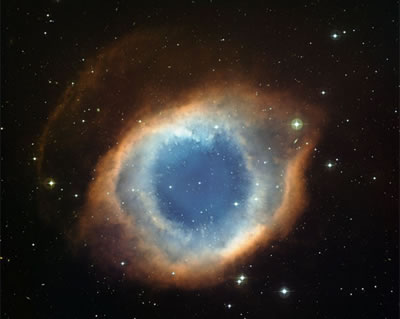Found this today...
Don't know what to talk about in regards to it, but just thought I'd share. They are calling it the "Eye of God."
Quote:This remarkable new image of the Helix nebula is a recent product of the European La Silla Observatory in Chile using a special camera attached to a telescope.

ESO explains that the Helix (NGC 7293) is the result of the "final blooming" of a Sun-like star before its "retirement" as a white dwarf.
Gas blown from the star's surface radiates outwards and "shines" under ultraviolet light from its hot progenitor. The photograph, taken by the Wide Field Imager attached to the 2.2-metre Max-Planck Society/ESO telescope, shows a central blue-green glow caused by "oxygen atoms shining under effects of the intense ultraviolet radiation of the 120,000°C central star and the hot gas".
ESO elaborates: "Further out from the star... the red colour from hydrogen and nitrogen is more prominent."
In their classic 1974 book The Mote in God's Eye, Larry Niven and Jerry Pournelle describe one of science fiction's most recognizable places - the Coal Sack. Here's the description of the Coal Sack, Murcheson's Eye and the Mote in God's Eye.
The Coal Sack was a nebular mass of dust and gas, small as such things go - twenty-four to thirty light years thick - but dense, and close enough to New Caledonia to block off a quarter of the sky. Earth and the Imperial Capital, Sparta, were forever invisible on its other side. The spreading blackness hid most of the Empire, but it made a fine velvet backdrop for two close, brilliant stars.
Even without that backdrop, Murcheson's Eye was the brightest star in the sky - a great red giant thirty-five light years distant. The white fleck at one edge was a yellow dwarf companion star, smaller and dimmer and less interesting: the Mote. Here the Coal Sack ahd the shape of a hooded man, head and shoulders; and the off-centered supergiant became a watchful, malevolent eye.
The Face of God.
Source:
http://www.technovelgy.com/ct/Science-Fiction-News.asp?NewsNum=2161
If you've got the time, I suggest poking around the Technovlelgy site. There is lots of fun stuff there to read up on.
T
K
O